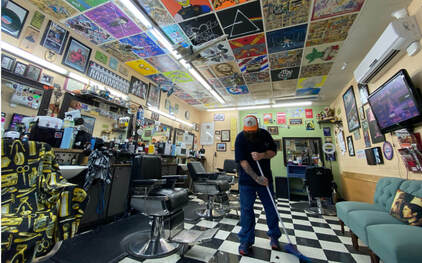Essential Sanitation Guidelines Professional Barber Should Apply to Protect Guest Well-being
Wiki Article
Hygiene is a critical component of operating a prosperous barber shop. As specialists, hairdressers are obligated for upholding a hygienic environment to guarantee the safety and health of their clients. This obligation goes beyond simply clearing the surface or cleaning down workstations. It involves comprehending and implementing fundamental sanitation protocols that shield both the barber and their customers from potential hazards. From appropriate handwashing methods to the correct management of equipment, mastering these procedures is essential for each hair professional.

Among the most vital sanitation protocols is proper hand care. Hair professionals should clean their palms thoroughly with cleansing soap and water both before and after each patron. This not only get rid of dirt and microbes but also prevents the circulation of infections. In cases where handwashing stations are not available, ethanol-based disinfectants can be applied as an substitute. It is essential to pay attention to spots such as under the nails and in finger gaps, as these places can carry microorganisms. Regularly instructing staff about the significance of hand cleanliness can significantly support a cleaner workspace.
Besides hand hygiene, effective cleaning and sterilizing of equipment are crucial in a barber shop workspace. All implements, including hair clippers, scissors, and brushes, should be sanitized after every use with antibacterial soap check out the post right here and clean water, followed by disinfecting using approved solutions. Cleaning solutions should be EPA-registered for efficacy against pathogens and microorganisms. It is also important to keep tools in a hygienic manner, making sure they do not be exposed to infected areas. By regularly cleaning and sterilizing equipment, stylists can prevent cross-contamination and protect their patrons protected from illnesses.
An additional key procedure involves ensuring hygiene within the barber shop facility. This covers daily cleaning practices for all spaces such as barber chairs, counters, and waiting areas. Shop floors should be cleaned consistently, and spills should be cleaned up at once to avoid slips. Disposal containers must be emptied frequently to prevent bad smells and rodent problems. Guaranteeing that the shop is well-ventilated helps maintain indoor air, creating a more comfortable environment for patrons. A clean shop not only promotes safety but also boosts the general image of the establishment.
In conclusion, grooming specialists should stay informed about public health rules and protocols from regional agencies regarding cleaning protocols. Joining training sessions can enable barbers to remain current on modern standards in cleanliness. Having awareness click here to read about disease-causing organisms and how to respond to emergency situations can further enhance client safety. Promoting an environment that prioritizes well-being shows expertise and creates confidence with customers who plan to revisit for ongoing care.
Learning critical hygiene standards is vital for each grooming professional who seeks to deliver a healthy space for their clients. By emphasizing appropriate hand care, thorough disinfection of equipment, upholding shop hygiene, and staying informed on health regulations, barbers can significantly reduce potential dangers in their facilities. Ultimately, these steps not only defend patrons but also support a barber's career growth. A dedication to sanitation reflects a dedication to excellent care that patrons will recognize and recall.